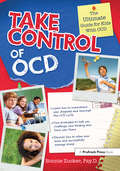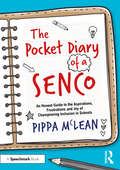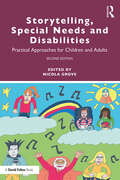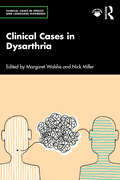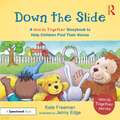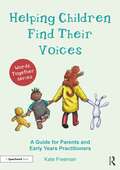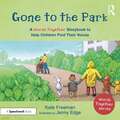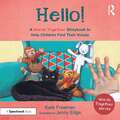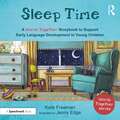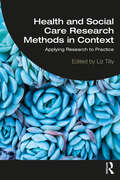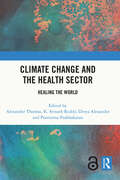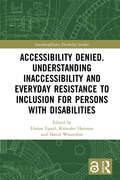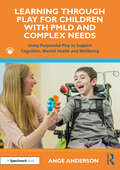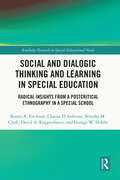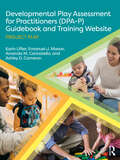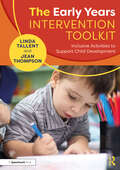- Table View
- List View
Take Control of OCD: The Ultimate Guide for Kids With OCD
by Bonnie ZuckerTake Control of OCD: The Ultimate Guide for Kids With OCD is a unique guide just for kids ages 10-16 with Obsessive-Compulsive Disorder to help them take control of their disorder and find success in school and in life. Using a cognitive-behavioral therapy method to stress gradual exposure to students' obsessive thinking patterns, the book takes kids step-by-step through a ladder-based process to conquer their fears and demolish their worries.Focusing on helping kids change their obsessive thoughts, tolerate uncertainty, develop positive self-talk and stress management, advocate for their needs in school, find successful relaxation procedures, and face their fears, the book includes workbook-style pages for kids to complete. By interviewing kids with OCD from across the country, the author offers tons of advice, information, and ideas for students, by students just like them. This handy guidebook is sure to help children with OCD change their behaviors and conquer their worries, discovering a sense of accomplishment and achievement.Ages 10-16
The Pocket Diary of a SENCO: An Honest Guide to the Aspirations, Frustrations and Joys of Championing Inclusion in Schools
by Pippa McLeanThe Pocket Diary of a SENCO spans a typical school year and includes hopeful and often humorous diary entries that share the authentic aspirations, joys, and frustrations of championing inclusion and working in the role of a SENCO. Grounded in real-life experiences and day-to-day practice, Pippa McLean describes the experiences of a SENCO and the reality of SEND provision in school, drawing out the personal characteristics and values that schools can foster to support inclusive practice and nurture positive relationships between children, parents, and colleagues. Diary extracts across the months range from ‘Be ready to hit the road’, ‘Be gentle on yourself’, to ‘Be a culture builder' and ‘Be an advocate'. Each entry is followed by reflective questions and space for the reader to jot down their own thoughts, as well as ‘monthly musings’ to support their own professional development. Written in a truly conversational style, this essential pocket diary captures the reality of SEND provision in schools and will be relatable to many. It is valuable reading for SENCOs, teachers, support staff and trainees who wish to enrich their learning around inclusive practice and engage reflectively within their busy lives.
Storytelling, Special Needs and Disabilities: Practical Approaches for Children and Adults
by Nicola GroveNow in a fully revised and updated second edition, this innovative and wide-ranging book shows how storytelling can open new worlds for individuals with special educational needs and disabilities. Providing a highly accessible combination of theory and practice, the contributors to this book define their own approaches to inclusive storytelling, describing the principles and theory that underpin their practice, whilst never losing sight of the joy at the heart of their work. Topics include therapeutic storytelling; language and communication; interactive and multi-sensory storytelling; and technology. Each chapter includes top tips, and signposts further training for practitioners who want to start using stories in their own work, making this book a crucial and comprehensive guide to storytelling practice with diverse learners. This new edition: · has been fully updated to reflect the way in which this field of storytelling has grown and developed · uses a broad range of chapters, structured in a way that guides the reader through the conceptualisation of a storytelling approach towards its practical application · includes an additional chapter, sharing the lived experiences of storytellers who identify as having a disability. Full of inspiring ideas to be used with people of all ages and with a range of needs, this book will be an invaluable tool for education professionals, as well as therapists, youth workers, counsellors and theatre practitioners working in special education.
Storytelling, Special Needs and Disabilities: Practical Approaches for Children and Adults
by Nicola GroveNow in a fully revised and updated second edition, this innovative and wide-ranging book shows how storytelling can open new worlds for individuals with special educational needs and disabilities. Providing a highly accessible combination of theory and practice, the contributors to this book define their own approaches to inclusive storytelling, describing the principles and theory that underpin their practice, whilst never losing sight of the joy at the heart of their work. Topics include therapeutic storytelling; language and communication; interactive and multi-sensory storytelling; and technology. Each chapter includes top tips, and signposts further training for practitioners who want to start using stories in their own work, making this book a crucial and comprehensive guide to storytelling practice with diverse learners. This new edition: · has been fully updated to reflect the way in which this field of storytelling has grown and developed · uses a broad range of chapters, structured in a way that guides the reader through the conceptualisation of a storytelling approach towards its practical application · includes an additional chapter, sharing the lived experiences of storytellers who identify as having a disability. Full of inspiring ideas to be used with people of all ages and with a range of needs, this book will be an invaluable tool for education professionals, as well as therapists, youth workers, counsellors and theatre practitioners working in special education.
Clinical Cases in Dysarthria (Clinical Cases in Speech and Language Disorders)
by Nick Miller Margaret WalsheThrough the medium of detailed clinical case reports, written by well-respected clinicians and researchers working internationally in the field, Clinical Cases in Dysarthria discusses the challenges, and rewards of applying evidence-based procedures to people with dysarthria in real-life busy routine clinical settings. The text opens with an introduction to the latest research and practices within dysarthria treatment and sets the scene for the eight individual case reports which follow. These case reports form the core chapters of the text and cover themes that range from clinical diagnostic conundrums to applying popular, and/or novel intervention approaches to different populations where dysarthria presents. Each chapter has a specific argument drawing on theoretical principles of assessment and rehabilitation, incorporating latest research evidence to help readers problem-solve similar cases in their clinical practice. Throughout the text, readers are encouraged to ‘think outside the box’. This book will be essential for undergraduate and postgraduate student clinicians within speech and language therapy/pathology courses, as well as clinicians new to the field of dysarthria.
Clinical Cases in Dysarthria (Clinical Cases in Speech and Language Disorders)
by Nick Miller Margaret WalsheThrough the medium of detailed clinical case reports, written by well-respected clinicians and researchers working internationally in the field, Clinical Cases in Dysarthria discusses the challenges, and rewards of applying evidence-based procedures to people with dysarthria in real-life busy routine clinical settings. The text opens with an introduction to the latest research and practices within dysarthria treatment and sets the scene for the eight individual case reports which follow. These case reports form the core chapters of the text and cover themes that range from clinical diagnostic conundrums to applying popular, and/or novel intervention approaches to different populations where dysarthria presents. Each chapter has a specific argument drawing on theoretical principles of assessment and rehabilitation, incorporating latest research evidence to help readers problem-solve similar cases in their clinical practice. Throughout the text, readers are encouraged to ‘think outside the box’. This book will be essential for undergraduate and postgraduate student clinicians within speech and language therapy/pathology courses, as well as clinicians new to the field of dysarthria.
Down the Slide: A ‘Words Together’ Storybook to Help Children Find Their Voices (Words Together)
by Kate FreemanDown the Slide, part of the ‘Words Together’ series, has been created to support children to understand and use two-word sentences. Using the pivot word ‘down’, the simple story and repetitious structure provide an opportunity for the child to hear and experience the sentence structure in new ways. Bright and colourful illustrations provide rich opportunities for conversation and engagement. This storybook is an exciting resource for early years practitioners, parents, and those working with children at an early stage of speech and language development.
Helping Children Find Their Voices: A Guide for Parents and Early Years Practitioners (Words Together)
by Kate FreemanDesigned to be used either independently or alongside the ‘Words Together’ storybooks, Helping Children Find Their Voices is a guide for parents and practitioners supporting children in the early stages of learning to talk, specifically to understand and use two-word sentences. Written in a friendly and reassuring tone, the book untangles questions and concerns that many parents and practitioners share around language development, such as whether children are reaching important milestones, whether they benefit from screen-time and dummies, and what to do if there might be a problem. Key features of this book include: • Chapters that can either be followed consecutively, offering tips on how to encourage first words and the combining of words into two-word sentences, or dipped in-and-out of according to the individual child’s level of development • Practical information and advice rooted in theory, giving parents and practitioners the confidence and background knowledge to support communication • Activities that can be integrated into everyday interactions, giving children the opportunity to hear simple sentence structures that they can progress towards in their own speech. Also available as part of a set, with four colourful picture books, this guide is an ideal resource for early years practitioners, parents, and those working with children who have delayed speech and language development.
Gone to the Park: A ‘Words Together’ Storybook to Help Children Find Their Voices (Words Together)
by Kate FreemanGone to the Park, part of the ‘Words Together’ series, has been created to support children to understand and use two-word sentences. Using the pivot word ‘gone’, the simple story and repetitious structure provide an opportunity for the child to hear and experience the sentence structure in new ways. Bright and colourful illustrations provide rich opportunities for conversation and engagement. This storybook is an exciting resource for early years practitioners, parents, and those working with children at an early stage of speech and language development.
Hello!: A 'Words Together' Storybook to Help Children Find Their Voices (Words Together)
by Kate FreemanHello!, part of the ‘Words Together’ series, has been created to support children to understand and use two-word sentences. Using the pivot word ‘hello’, the simple story and repetitious structure provide an opportunity for the child to hear and experience the sentence structure in new ways. Bright and colourful illustrations provide rich opportunities for conversation and engagement. This storybook is an exciting resource for early years practitioners, parents, and those working with children at an early stage of speech and language development.
Sleep Time: A 'Words Together' Storybook to Help Children Find Their Voices (Words Together)
by Kate FreemanSleep Time, part of the ‘Words Together’ series, has been created to support children to understand and use two-word sentences. Using the pivot word ‘sleeping’, the simple story and repetitious structure provide an opportunity for the child to hear and experience the sentence structure in new ways. Bright and colourful illustrations provide rich opportunities for conversation and engagement. This storybook is an exciting resource for early years practitioners, parents, and those working with children at an early stage of speech and language development.
Health and Social Care Research Methods in Context: Applying Research to Practice
by Liz TillyThis is the first textbook to show how research using a range of qualitative and quantitative methods relates to improving health and social care practice. The book shows how different research approaches are undertaken in practice and the challenges and strengths of different methodologies, thus facilitating students to make informed decisions when choosing which to use in their own research projects. The eleven chapters are each structured around different research methods and include: A brief overview of the research and research question Identification and overview of the research approach and associated methods selected to answer this question The sample and recruitment, including issues and challenges Ethical concerns Practical issues in undertaking the research approach Links between the research process and findings to health and social care values Links to the full research study Further reading The book will be a required reading for all students of social work; social care; nursing; public health and health studies and particularly suitable for those on widening participation courses.
Climate Change and the Health Sector: Healing the World
by Alexander Thomas K. Srinath Reddy Divya Alexander Poornima PrabhakaranThe health sector is known to be one of the major contributors towards the greenhouse gas emissions causing the climate crisis, the greatest health threat of the 21st century. This volume positions the health sector as a leader in the fight against climate change and explores the role of the health system in climate policy action. It delivers an overview of the linkages between climate change and the health sector, with chapters on the impact of climate change on health, its connection to pandemics, and its effects on food, nutrition and air quality, while examining gendered and other vulnerabilities. It delves into the different operational aspects of the health sector in India and details how each one can become climate-smart to reduce the health sector’s overall carbon footprint, by looking at sustainable procurement, green and resilient healthcare infrastructure, and the management of transportation, energy, water, waste, chemicals, pharmaceuticals and plastics in healthcare. Well supplemented with rigorous case studies, the book will be indispensable for students, teachers, and researchers of environmental studies, health sciences, and climate change. It will be useful for healthcare workers, public health officials, healthcare leaders, policy planners, and those interested in climate resilience and preparedness in the healthcare sector.
Health and Social Care Research Methods in Context: Applying Research to Practice
by Liz TillyThis is the first textbook to show how research using a range of qualitative and quantitative methods relates to improving health and social care practice. The book shows how different research approaches are undertaken in practice and the challenges and strengths of different methodologies, thus facilitating students to make informed decisions when choosing which to use in their own research projects. The eleven chapters are each structured around different research methods and include: A brief overview of the research and research question Identification and overview of the research approach and associated methods selected to answer this question The sample and recruitment, including issues and challenges Ethical concerns Practical issues in undertaking the research approach Links between the research process and findings to health and social care values Links to the full research study Further reading The book will be a required reading for all students of social work; social care; nursing; public health and health studies and particularly suitable for those on widening participation courses.
Climate Change and the Health Sector: Healing the World
by Alexander Thomas K. Srinath Reddy Divya Alexander Poornima PrabhakaranThe health sector is known to be one of the major contributors towards the greenhouse gas emissions causing the climate crisis, the greatest health threat of the 21st century. This volume positions the health sector as a leader in the fight against climate change and explores the role of the health system in climate policy action. It delivers an overview of the linkages between climate change and the health sector, with chapters on the impact of climate change on health, its connection to pandemics, and its effects on food, nutrition and air quality, while examining gendered and other vulnerabilities. It delves into the different operational aspects of the health sector in India and details how each one can become climate-smart to reduce the health sector’s overall carbon footprint, by looking at sustainable procurement, green and resilient healthcare infrastructure, and the management of transportation, energy, water, waste, chemicals, pharmaceuticals and plastics in healthcare. Well supplemented with rigorous case studies, the book will be indispensable for students, teachers, and researchers of environmental studies, health sciences, and climate change. It will be useful for healthcare workers, public health officials, healthcare leaders, policy planners, and those interested in climate resilience and preparedness in the healthcare sector.
Accessibility Denied. Understanding Inaccessibility and Everyday Resistance to Inclusion for Persons with Disabilities (Interdisciplinary Disability Studies)
by Hanna Egard Kristofer Hansson David WästerforsThis book explores the societal resistance to accessibility for persons with disabilities, and tries to set an example of how to study exclusion in a time when numerous policies promise inclusion. With 12 chapters organised in three parts, the book takes a comprehensive approach to accessibility, covering transport and communication, knowledge and education, law and organisation. Topics within a wide cross-disciplinary field are covered, including disability studies, social work, sociology, ethnology, social anthropology, and history. The main example is Sweden, with its implementation of the United Nations Convention on the Rights of Persons with Disabilities within the context of the Nordic welfare state. By identifying and discussing persistent social and cultural conditions as well as recurring situations and interactions that nurture resistance to advancing accessibility, despite various strong laws promoting it, the book’s conclusions are widely transferable. It argues for the value of alternating between methods, theoretical perspectives, and datasets to explore how new arenas, resources and technologies cause new accessibility concerns — and possibilities — for persons living with impairments. We need to be able to follow actors closely to uncover how they feel, act, and argue, but also to connect to wider discursive and institutional patterns and systems. This book will be of interest to scholars and students of disability studies, social work, sociology, ethnology, social anthropology, political science, and organisation studies.
Accessibility Denied. Understanding Inaccessibility and Everyday Resistance to Inclusion for Persons with Disabilities (Interdisciplinary Disability Studies)
by Hanna EgardThis book explores the societal resistance to accessibility for persons with disabilities, and tries to set an example of how to study exclusion in a time when numerous policies promise inclusion. With 12 chapters organised in three parts, the book takes a comprehensive approach to accessibility, covering transport and communication, knowledge and education, law and organisation. Topics within a wide cross-disciplinary field are covered, including disability studies, social work, sociology, ethnology, social anthropology, and history. The main example is Sweden, with its implementation of the United Nations Convention on the Rights of Persons with Disabilities within the context of the Nordic welfare state. By identifying and discussing persistent social and cultural conditions as well as recurring situations and interactions that nurture resistance to advancing accessibility, despite various strong laws promoting it, the book’s conclusions are widely transferable. It argues for the value of alternating between methods, theoretical perspectives, and datasets to explore how new arenas, resources and technologies cause new accessibility concerns — and possibilities — for persons living with impairments. We need to be able to follow actors closely to uncover how they feel, act, and argue, but also to connect to wider discursive and institutional patterns and systems. This book will be of interest to scholars and students of disability studies, social work, sociology, ethnology, social anthropology, political science, and organisation studies.
Learning Through Play for Children with PMLD and Complex Needs: Using Purposeful Play to Support Cognition, Mental Health and Wellbeing
by Ange AndersonThis book examines the development of play skills and schemas to support children with learning differences and physical disabilities in learning to play. It highlights the need for appropriate playground equipment in all school settings that educate children with physical disabilities and sensory needs to ensure equal opportunities for outdoor play. Several play approaches for meeting sensory needs are discussed including Lego therapy, Art therapy, Sand play and Soft play. Digital play for students with physical disabilities is an important chapter in the book. Role play and the ways in which virtual reality and psychodrama support anxieties that some students have is another important chapter. There is also a chapter devoted to parents on how they can support their child at home and how the school can support them. At the end of the book there is a plethora of resources that readers can copy or adapt to suit their setting. The book provides support for those managing outdoor play for these children at peak times of the day. It shows how play-based learning can work in a classroom setting; the importance of sensory profiles and sensory play; and how play therapy can aid neuroplasticity.
Learning Through Play for Children with PMLD and Complex Needs: Using Purposeful Play to Support Cognition, Mental Health and Wellbeing
by Ange AndersonThis book examines the development of play skills and schemas to support children with learning differences and physical disabilities in learning to play. It highlights the need for appropriate playground equipment in all school settings that educate children with physical disabilities and sensory needs to ensure equal opportunities for outdoor play. Several play approaches for meeting sensory needs are discussed including Lego therapy, Art therapy, Sand play and Soft play. Digital play for students with physical disabilities is an important chapter in the book. Role play and the ways in which virtual reality and psychodrama support anxieties that some students have is another important chapter. There is also a chapter devoted to parents on how they can support their child at home and how the school can support them. At the end of the book there is a plethora of resources that readers can copy or adapt to suit their setting. The book provides support for those managing outdoor play for these children at peak times of the day. It shows how play-based learning can work in a classroom setting; the importance of sensory profiles and sensory play; and how play therapy can aid neuroplasticity.
Social and Dialogic Thinking and Learning in Special Education: Radical Insights from a Post-Critical Ethnography in a Special School (Routledge Research in Special Educational Needs)
by Karen A. Erickson Charna D’Ardenne Nitasha M. Clark David A. Koppenhaver George W. NoblitDrawing on a three-year post-critical ethnography, this volume counters deficit-based notions of disability to present a new social and dialogic theory of thinking and learning for students with significant support needs. Dismantling ideas around ableism/disableism, Social and Dialogic Thinking and Learning offers a uniquely theoretical and conceptual contribution to special education and capability research. Illustrating how students exhibit varied practical, social, and creative abilities, possess agency and perform identity, chapters present a challenge to the restrictive ways in which disability is constructed through prescriptive forms of teacher-student interaction and instruction. The text ultimately offers a powerful re-imagining of how educators and researchers can perceive, observe, and respond to students beyond current institutional and cultural norms. This text will benefit researchers, academics, and educators with an interest in inclusion and special educational needs, disability studies, and the theories of learning more broadly. Those specifically interested in educational psychology and the study of severe, profound, and multiple learning difficulties will also benefit from this book.
Social and Dialogic Thinking and Learning in Special Education: Radical Insights from a Post-Critical Ethnography in a Special School (Routledge Research in Special Educational Needs)
by Karen A. Erickson Charna D’Ardenne Nitasha M. Clark David A. Koppenhaver George W. NoblitDrawing on a three-year post-critical ethnography, this volume counters deficit-based notions of disability to present a new social and dialogic theory of thinking and learning for students with significant support needs. Dismantling ideas around ableism/disableism, Social and Dialogic Thinking and Learning offers a uniquely theoretical and conceptual contribution to special education and capability research. Illustrating how students exhibit varied practical, social, and creative abilities, possess agency and perform identity, chapters present a challenge to the restrictive ways in which disability is constructed through prescriptive forms of teacher-student interaction and instruction. The text ultimately offers a powerful re-imagining of how educators and researchers can perceive, observe, and respond to students beyond current institutional and cultural norms. This text will benefit researchers, academics, and educators with an interest in inclusion and special educational needs, disability studies, and the theories of learning more broadly. Those specifically interested in educational psychology and the study of severe, profound, and multiple learning difficulties will also benefit from this book.
Developmental Play Assessment for Practitioners (DPA-P) Guidebook and Training Website: Project Play
by Karin Lifter Emanuel J. Mason Amanda M. Cannarella Ashley D. CameronDevelopmental Play Assessment for Practitioners (DPA-P) Guidebook and Training Website: Project Play offers a comprehensive assessment of naturally occurring play activities for evaluating young children’s developmental progress accurately, so that useful interventions can take place as early as possible. It can be used by practitioners in a wide range of educational and therapeutic settings and is designed to support developmental progress through planning interventions in play, and using what we know about a child’s progress in play to plan play-based interventions in cognition, language, motor, social-emotional, and self-help skills. The guidebook and training website provide a comprehensive introduction to how to successfully use the assessment with infants, toddlers, and young children with disabilities or at risk for disabilities. The comprehensive guidebook offers an overview of the DPA-P and Project Play, defines play, discusses the background literature on play, and explains why this assessment is needed. Clear guidance helps practitioners and family members understand play, how to evaluate play, and how to use play for different purposes. The guidebook offers: an introduction to the comprehensive training website and how to use it understanding of the categories of play assessed and their definitions guidance on how to administer the assessment and prepare a summary evaluation of a child’s performance clear instructions for the coding sheets and scoring guidelines for constructing sets of toys guidance on taking the results of the DPA-P evaluation of a child’s progress in play to develop a plan of activities for intervention explanation of how you evaluate activities at the absence, basic, emergence, and mastery levels for developing a plan suggestions for assembling sets of toys for intervention, based on toys available in children’s homes and early childhood settings procedures for facilitating or teaching play activities to children who are developing more slowly than their peers technical aspects of the assessment To make the DPA-P as flexible as possible for all practitioners, it also offers guidance on adaptations for administering the test, in the coding sheets, with toys to enhance cultural appropriateness for gathering the observations, and for supporting interventions in play. The Developmental Play Assessment for Practitioners (DPA-P) can be used in natural settings and takes 30 minutes to complete. It is a valuable tool for all those who serve, or are training to serve, young children in early childhood settings, schools, service agencies, colleges, and universities. It will be of great benefit for early intervention personnel, speech-language pathologists, physical therapists, occupational therapists, and psychologists.
Developmental Play Assessment for Practitioners (DPA-P) Guidebook and Training Website: Project Play
by Karin Lifter Emanuel J. Mason Amanda M. Cannarella Ashley D. CameronDevelopmental Play Assessment for Practitioners (DPA-P) Guidebook and Training Website: Project Play offers a comprehensive assessment of naturally occurring play activities for evaluating young children’s developmental progress accurately, so that useful interventions can take place as early as possible. It can be used by practitioners in a wide range of educational and therapeutic settings and is designed to support developmental progress through planning interventions in play, and using what we know about a child’s progress in play to plan play-based interventions in cognition, language, motor, social-emotional, and self-help skills. The guidebook and training website provide a comprehensive introduction to how to successfully use the assessment with infants, toddlers, and young children with disabilities or at risk for disabilities. The comprehensive guidebook offers an overview of the DPA-P and Project Play, defines play, discusses the background literature on play, and explains why this assessment is needed. Clear guidance helps practitioners and family members understand play, how to evaluate play, and how to use play for different purposes. The guidebook offers: an introduction to the comprehensive training website and how to use it understanding of the categories of play assessed and their definitions guidance on how to administer the assessment and prepare a summary evaluation of a child’s performance clear instructions for the coding sheets and scoring guidelines for constructing sets of toys guidance on taking the results of the DPA-P evaluation of a child’s progress in play to develop a plan of activities for intervention explanation of how you evaluate activities at the absence, basic, emergence, and mastery levels for developing a plan suggestions for assembling sets of toys for intervention, based on toys available in children’s homes and early childhood settings procedures for facilitating or teaching play activities to children who are developing more slowly than their peers technical aspects of the assessment To make the DPA-P as flexible as possible for all practitioners, it also offers guidance on adaptations for administering the test, in the coding sheets, with toys to enhance cultural appropriateness for gathering the observations, and for supporting interventions in play. The Developmental Play Assessment for Practitioners (DPA-P) can be used in natural settings and takes 30 minutes to complete. It is a valuable tool for all those who serve, or are training to serve, young children in early childhood settings, schools, service agencies, colleges, and universities. It will be of great benefit for early intervention personnel, speech-language pathologists, physical therapists, occupational therapists, and psychologists.
The Early Years Intervention Toolkit: Inclusive Activities to Support Child Development
by Linda Tallent Jean ThompsonThe Early Years Intervention Toolkit provides a range of ready-made activities to enable early years practitioners and health visitors to address observed difficulties in a child’s development prior to starting school. It includes a checklist of observed behaviours which links to a range of effective and engaging activities to support children’s development across the three prime foundational areas of learning: Communication and Language; Physical Development; and Personal, Social and Emotional Development. Activities focus on a variety of crucial skills such as speaking and listening, moving and handling, and forming relationships, making use of materials that are readily available in every early years setting. This toolkit offers: A time-saving approach to interventions, with additional guidance on planning, providing, and recording appropriate interventions Advice and activities to share with parents for them to try at home A framework to enable early years practitioners to identify specific difficulties in key areas of development Downloadable resources to support activities and interventions The Early Years Intervention Toolkit is an inclusive programme and all children in the early years will benefit from taking part in the activities. It will be an essential resource for early years practitioners to effectively identify and support learning needs in child development and will boost the confidence of young children as they prepare for Key Stage One.
The Early Years Intervention Toolkit: Inclusive Activities to Support Child Development
by Linda Tallent Jean ThompsonThe Early Years Intervention Toolkit provides a range of ready-made activities to enable early years practitioners and health visitors to address observed difficulties in a child’s development prior to starting school. It includes a checklist of observed behaviours which links to a range of effective and engaging activities to support children’s development across the three prime foundational areas of learning: Communication and Language; Physical Development; and Personal, Social and Emotional Development. Activities focus on a variety of crucial skills such as speaking and listening, moving and handling, and forming relationships, making use of materials that are readily available in every early years setting. This toolkit offers: A time-saving approach to interventions, with additional guidance on planning, providing, and recording appropriate interventions Advice and activities to share with parents for them to try at home A framework to enable early years practitioners to identify specific difficulties in key areas of development Downloadable resources to support activities and interventions The Early Years Intervention Toolkit is an inclusive programme and all children in the early years will benefit from taking part in the activities. It will be an essential resource for early years practitioners to effectively identify and support learning needs in child development and will boost the confidence of young children as they prepare for Key Stage One.
